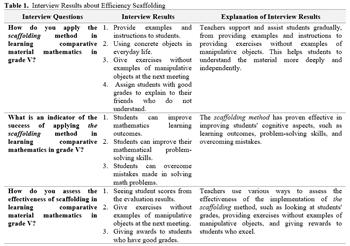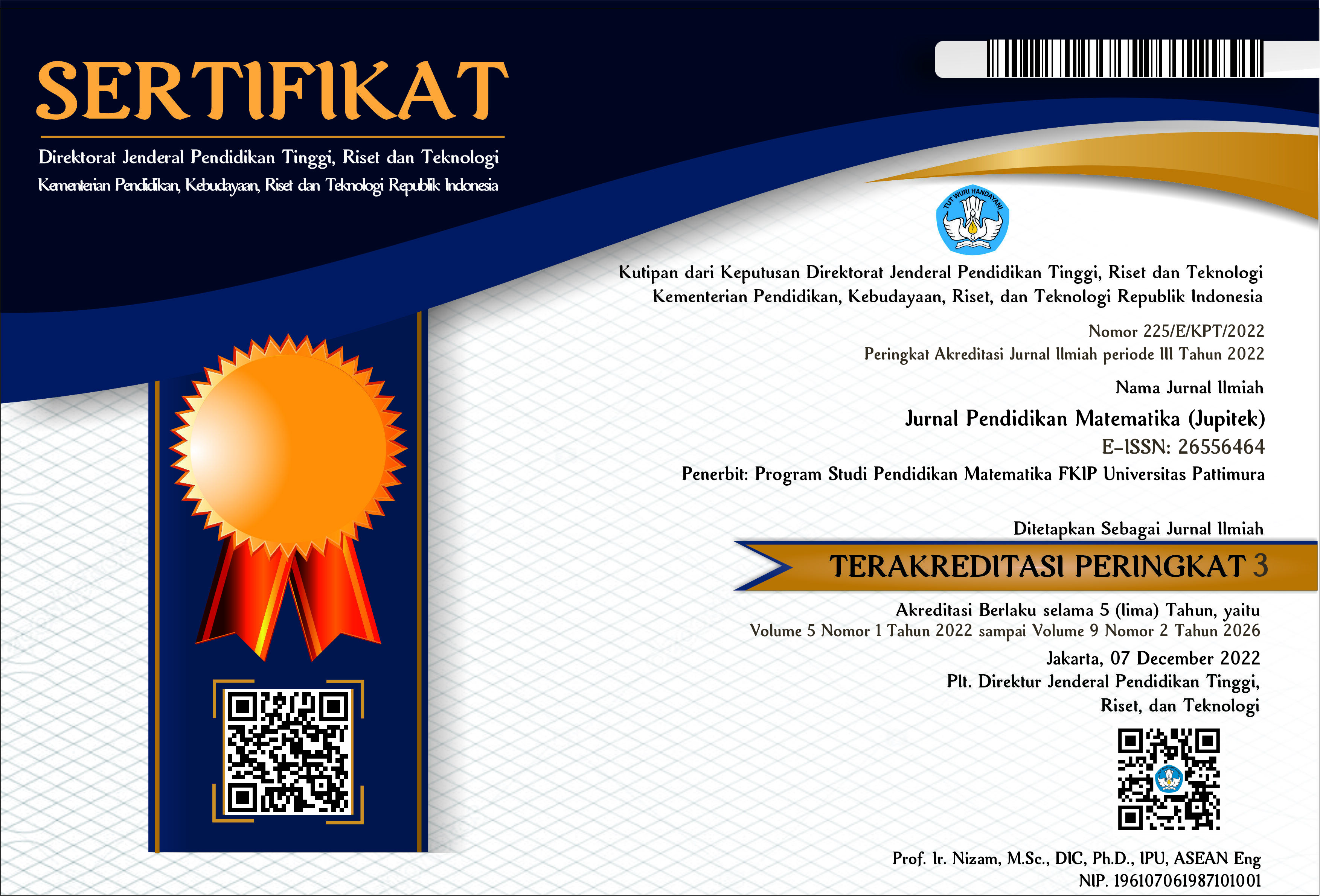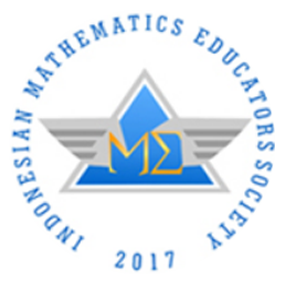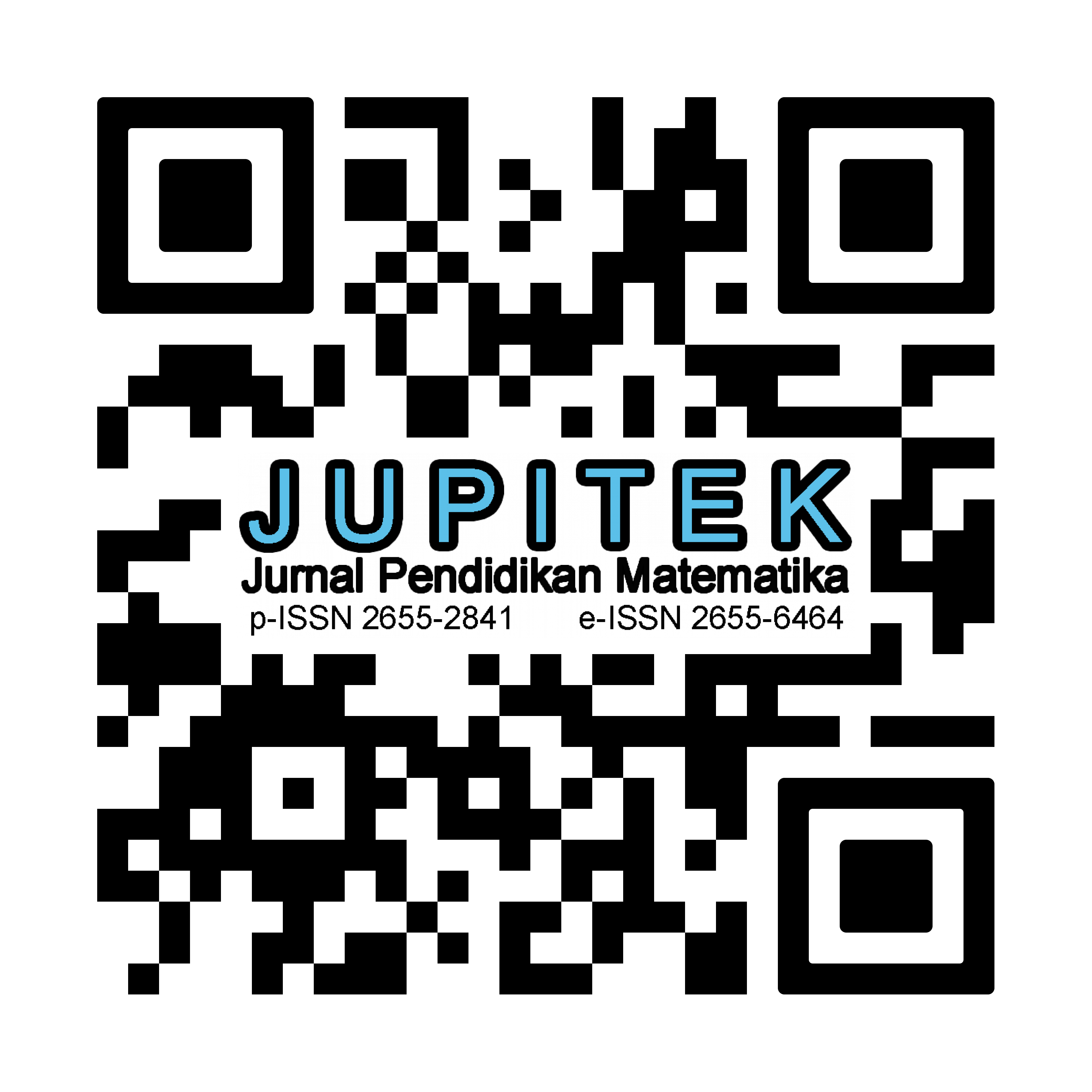EFFICIENCY OF SCAFFOLDING METHOD IN THE LEARNING PROCESS OF MATHEMATICS COMPARATIVE MATERIAL IN GRADE V ELEMENTARY SCHOOL STUDENTS
Abstract
The conceptual understanding of comparative mathematics remains a significant challenge in elementary education, as students rely heavily on formulaic approaches rather than developing deeper comprehension. This condition highlights the importance of the role of teachers in assisting with learning methods such as scaffolding. This study aims to analyze the efficiency of the scaffolding method in improving students' cognitive aspects. Scaffolding can help students improve mathematics learning outcomes and mathematical problem-solving skills and improve the cognitive aspect applied to grade V students in one of the state elementary schools in the Pondok Kacang area. This study uses a descriptive qualitative approach with data collection through observation, interviews, and documentation with data sources of a teacher and 3 grade V students in one of the State Elementary Schools in the Pondok Kacang area. The results of the study on the application of the scaffolding method to improving cognitive aspects in students in the context of learning mathematics ratio materials show that the application of the scaffolding method is efficient and effective; this can be seen from the improvement of students' cognitive aspects through assisting children in the early stages of their development, applying a multi-level approach, and efforts to follow the characteristics of scaffolding when there is an argument between students and teachers. The scaffolding method improves students' cognitive aspects by using motivational strategies and associating students' interests with learning assignments. Therefore, the scaffolding method plays a role in developing students' cognitive skills, especially in mathematics
Downloads
References
Basri, M., & Arsal, R. (2022). Pengaruh Efektivitas Dan Efisiensi Kerja Pegawai Terhadap Kinerja Organisasi Dinas Sosial Kota Kendari. Jurnal Public Uho, 5(4), 1127–1138.
Cahyo, A. N. (2013). Panduan Aplikasi Teori-Teori Belajar Mengajar Teraktual dan Terpopuler. Jogyakarta: DIVA Press.
Cho, M. K., & Kim, M. K. (2020). Investigating elementary students’ problem solving and teacher scaffolding in solving an Ill-structured problem. International Journal of Education in Mathematics, Science and Technology, 8(4), 274–289. Scopus. https://doi.org/10.46328/IJEMST.V8I4.1148
Damayanti, N. I., Sarvia, & Rustanuarsi, R. (2022). Identifikasi Ayat-Ayat Al-Qur’an Yang Memuat Konsep Aritmetika. Jurnal Al’adad: Jurnal Tadris Matematika.
Dua, I. L., & Rumerung, J. L. (2021). Kajian Efisiensi Dan Efektivitas Kerja Karyawan Bidang Administrasi Pada Pt. Manado Media Grafika. Jurnal Manajemen Administrasi Bisnis Dan Pemasaran, 4(1), 118–132.
Fadila, P., Koryati, K., & Djumadiono. (2014). Pengaruh Penerapan Pendekatan Pembelajaran Scaffolding Terhadap Motivasi Belajar Siswa Pada Mata Pelajaran Ekonomi di SMA Negeri 15 Palembang. Jurnal Profit, 1(1), 63–77.
Handayani, H. (2020). Pengaruh Implementasi Pembelajaran Kooperatif Tipe Jigsaw Terhadap Kemampuan Berpikir Kritis Matematis Siswa Sekolah Dasar. Pendas: Jurnal Ilmiah Pendidikan Dasar, 5(1), 50–60.
Hartono, S., Siswono, T. Y. E., & Ekawati, R. (2024). From Informal to Formal Proof in Geometry: A Preliminary Study of Scaffolding-based Interventions for Improving Preservice Teachers’ Level of Proof. Mathematics Teaching-Research Journal, 16(2), 48–62. Scopus.
Hidayat, I., Fitrianingrum, L., & Hudiwasono, K. (2021). Penerapan Prinsip Efektif dan Efisien dalam Pelaksanaan Monitoring Kegiatan Penelitian. Majalah Media Perencana, 2(1), 42–50.
Lestari, S. I., & Andriani, L. (2019). Pengaruh Penerapan Strategi Pembelajaran Scaffolding terhadap Kemampuan Pemahaman Konsep Matematis Siswa Madrasah Tsanawiyah Al-Hidayah Singingi Hilir ditinjau dari Motivasi Belajar Siswa. Suska Journal of Mathematics Education, 5(1), 68–76.
Li, R., Cevikbas, M., & Kaiser, G. (2024). Mathematics teachers’ beliefs about their roles in teaching mathematics: Orchestrating scaffolding in cooperative learning. Educational Studies in Mathematics, 117(3), 357–377. https://doi.org/10.1007/s10649-024-10359-9
Maharani, I. P., & Subanji, S. (2018). Scaffolding Based on Cognitive Conflict in Correcting the Students’ Algebra Errors. International Electronic Journal of Mathematics Education, 13(2), 67–74.
Pol, J., Volman, M., & Beishuizen, J. (2010). Scaffolding in Teacher- Student Interaction: A Decade of Research. Educ. Psychol. Rev, 22(3), 271–296.
Pradana, M. I. W., & Mahendra, G. K. (2021). Analisis Dampak Covid-19 Terhadap Sektor Pariwisata Di Objek Wisata Goa Pindul Kabupaten Gunungkidul. Journal of Social Politics and Governance, 3(2), 73–85.
Pramudita, W., & Anugraheni, I. (2017). Studi Penguasaan Matematika Dan Bahasa Inggris Mahasiswa Program Studi Pendidikan Guru Sekolah Dasar (PGSD). Scholaria: Jurnal Pendidikan Dan Kebudayaan, 7(1), 70–82.
Rachamim, M., Berman, A., & Koichu, B. (2024). Using scaffolds in support of teachers as task designers in geometry: A case study. International Journal of Mathematical Education in Science and Technology, 55(8), 1875–1895. Scopus. https://doi.org/10.1080/0020739X.2022.2100293
Rahayu, P., Warli, & Cintamulya, I. (2020). Scaffolding dalam Pembelajaran Mata Kuliah Struktur Aljabar. Jurnal Ilmiah Pendidikan Matematika, 5(1), 25–35.
Rezat, S., Malik, S., & Leifeld, M. (2022). Scaffolding Close Reading of Mathematical Text in Pre-service Primary Teacher Education at the Tertiary Level: Design and Evaluation. International Journal of Science and Mathematics Education, 20, 215–236. Scopus. https://doi.org/10.1007/s10763-022-10309-y
Schons, C., Obersteiner, A., Reinhold, F., Fischer, F., & Reiss, K. (2023). Developing a Simulation to Foster Prospective Mathematics Teachers’ Diagnostic Competencies: The Effects of Scaffolding. Journal Fur Mathematik-Didaktik, 44(1), 59–82. Scopus. https://doi.org/10.1007/s13138-022-00210-0
Septiani, Y., Arribe, E., & Diansyah, R. (2020). Analisis Kualitan Layanan Sistem Informasi Akademik Universitas Abdurrab Terhadap Kepuasan Pengguna Menggunakan Metode Sevqual. Jurnal Teknologi Dan Open Source, 3(1), 131–143.
Siller, H.-S., Nitzan-Tamar, O., & Kohen, Z. (2023). Scaffolding practices for modelling instruction in STEM-related contexts: Insights from expert and novice teachers. ZDM - Mathematics Education, 55(7), 1351–1364. Scopus. https://doi.org/10.1007/s11858-023-01529-9
Sudarman, W. S., & Linuhung, N. (2017). Pengaruh Pembelajaran Scafolding Terhadap Pemahaman Konsep Integral Mahasiswa. AKSIOMA: Jurnal Program Studi Pendidikan Matematika, 6(1), 33–39.
Sugiyono. (2014). Metode Penelitian Pendidikan Kualitatif, Kuantitatif, dan R&D. Bandung: Alfabeta.
Suwarni, S. (2017). Peningkatan Hasil Belajar Perbandingan dan Skala melalui Pembelajaran Matematika Realistik. Briliant: Jurnal Riset Dan Koseptual, 2(1), 58–65.
Suwastini, N. K. A., Ersani, N. P. D., Padmadewi, N. N., & Artini, L. P. (2021). Schemes of Scaffolding in Online Education. RETORIKA: Jurnal Ilmu Bahasa, 7(1), 10–18. https://doi.org/10.22225/jr.7.1.2941.10-18
Trianto, I. B. (2014). Mendesain Model Pembelajaran Inovatif, Progresif, dan Kontekstual. Jakarta: Penerbit Prenadamedia Group.
Walkington, C., Bernacki, M., Wang, M., Istas, B., & Greene, M. (2024). Posing mathematics problems about STEM careers: Problem quality, scaffolds, and problem solving. International Journal of Mathematical Education in Science and Technology, 55(9), 2136–2169. Scopus. https://doi.org/10.1080/0020739X.2022.2128458

Copyright (c) 2025 Muhamad Diva Saidul, Nurbaiti Widyasari

This work is licensed under a Creative Commons Attribution-NonCommercial-ShareAlike 4.0 International License.
License and Copyright Agreement
By submitting a manuscript to Jurnal Pendidikan Matematika (JUPITEK), the author(s) certify and agree to the following terms:
- Originality and Authority: The submitting author is authorized by all co-authors to enter into this agreement. The manuscript describes original work that has not been published previously in a peer-reviewed journal, nor is it under consideration for publication elsewhere.
- Approval: Its publication has been approved by all author(s) and by the responsible authorities of the institutions where the work was carried out.
- Rights: The authors secure the right to reproduce any material that has already been published or copyrighted elsewhere.
- Licensing and Copyright: Authors retain the copyright to their work.
- License Grant: The authors grant Jurnal Pendidikan Matematika (JUPITEK) the right of first publication, with the work simultaneously licensed under the Creative Commons Attribution-NonCommercial-ShareAlike 4.0 International (CC BY-NC-SA 4.0).
- Self-Archiving: Authors are permitted and encouraged to deposit the published version of their article in institutional repositories, on their personal websites, and other academic platforms, with proper acknowledgment of its initial publication in Jurnal Pendidikan Matematika (JUPITEK).





.png)


